Buy AutoTrafficRSS script now for $27 only!
We will send the script to your PayPal email within few hours,Please add FullContentRSS@gmail.com to your email contact.Source: #SEO #News Roundup: #Google Adds New Feature To The #SERPs
Buy AutoTrafficRSS script now for $27 only!
We will send the script to your PayPal email within few hours,Please add FullContentRSS@gmail.com to your email contact.Search Engine Journal "SEJ" is helping marketers succeed by producing best-in-industry guides and information while cultivating a positive community. We cover the marketing world daily with in-depth subject guides, breaking news, argumentative and observational posts by expert guest contributors.
Buy AutoTrafficRSS script now for $27 only!
We will send the script to your PayPal email within few hours,Please add FullContentRSS@gmail.com to your email contact.TORONTO, Aug. 30, 2016 /CNW/ - Search Engine Land recently unveiled a shortlist of 89 nominees in 18 categories for the 2016 Landy Awards, compiled from leading digital agencies, in-house marketing teams, and individuals around the world.
From the nearly 200 submissions that applied for this year's awards, Eden Advertising & Interactive has been selected as one of this year's finalists in the category for Best Overall Search Marketing Initiative – SEO & SEM.
Eden submitted their case study involving a Canadian, short-term loans company, MagicalCredit.ca. Directing and implementing Magical Credit's SEO and Paid Search since their operations opened in 2014, Eden has transformed this start-up business into a recognized short-term loan company Canadians can easily find online and trust.
Eden quickly surpassed the company's goals and expectations of building online brand awareness and driving qualified leads to the site. Eden's SEO and Paid Search initiatives for MagicalCredit.ca in 2016, compared to the previous year, saw a significant climb in keyword rankings, overall traffic, direct website visits, online goal conversions, phone calls, and more.
During the campaign period, Eden achieved the following highlights:
"We're extremely excited and honoured to be recognized by Search Engine Land for our SEO and SEM marketing initiatives for MagicalCredit.ca," said Esther Willinger, president of Eden Advertising & Interactive, in a statement.
"We believe that every marketing concept can be optimized. Carefully selecting the right message, in combination with creative and appropriate media is essential to connecting our clients with customers that need their products and services. Being a Landy Finalist further reinforces that we are doing something right in our results-driven approach to SEO and SEM services for our clients."
Mark Joseph, President and Founder of MagicalCredit.ca also commented: "We've been working with Eden from the beginning. They helped us build our brand and strong online foundations from day one, so that all our online marketing plans could be seamlessly integrated, tracked, and expanded as needed. We are pleased, but not surprised, that Eden was chosen as a finalist for BEST Overall Search Marketing Initiative – SEO & SEM. We are very proud to be an Eden client and look forward to our ongoing growth together."
In the increasingly competitive search advertising space, campaigns submitted for consideration displayed innovative tactics and execution of strategic initiatives.
"The high level of sophistication and creativity of the campaigns submitted this year was inspiring. They made judging tough, but never boring," adds Ginny Marvin, Paid Media Reporter at SearchEngineLand.com.
Winners will be announced during an evening awards ceremony and celebratory gala held on September 28, 2016 in New York City. The Landy Awards gala will be a an industry celebration during the week of Search Engine Land's annual SMX East Conference, where the search industry gathers for continuing education on best practices in SEO and search advertising.
Eden Advertising – http://www.edenadvertising.comEden Advertising & Interactive is a full-service advertising agency located in Toronto. Eden specializes in results-driven marketing that provides clients with optimized online and offline marketing solutions that are proven to generate maximum results.
SOURCE Eden Advertising & Interactive Inc.
Image with caption: "The Second Annual Search Industry Competition Honors Best-in-Class SEO & SEM Efforts by Digital Marketing Agencies, Corporate Teams, and Individuals Around the World. (CNW Group/Eden Advertising & Interactive Inc.)". Image available at: http://photos.newswire.ca/images/download/20160830_C7229_PHOTO_EN_761643.jpg 
For further information: Esther Willinger, Email: advertise@edenadvertising.com, Tel: (905) 669-9550, Fax: (905) 669-0712
RELATED LINKSwww.edenadvertising.comBuy AutoTrafficRSS script now for $27 only!
We will send the script to your PayPal email within few hours,Please add FullContentRSS@gmail.com to your email contact.Establishing efficient search engine marketing and optimization campaigns for medical experts involve a vaguely dissimilar approach for other experts. There are many different causes for such case. Besides concerns associated AMA, FDA, plus other regulatory rules for physician promotion online, medical websites have their individual challenges.
In some instances, the medical professional is the initial challenge. In several cases doctors look forward to get their site traffic from users who seek them on the basis of their first name. This is hardly ever the case. A few more internet savvy physicians are responsive that people are really seeking specialties and medical terms.
Specific expressions are not as ordinary, however can be rather profitable. For example, a person seeking "dentists" may need anything from a general cleaning of teeth to a root canal, but a person who is searching for "oral surgeons" are possibly experiencing a more costly problem. As medical search engines experts, your primary task involves refining dentists, doctors, and other practitioners about what search-engines are seeking, and how users employ search engines.
TIPS
Here are a few simple tips for improved search engine rankings and growth of new patients-
1. If you are working in a hometown, ensure that you specify your office location as well as close by communities or towns from which you wait for patients.
2. Ensure that your website has a contemporary and clean appearance that boosts confidence.
3. Give your contact numbers significantly at every page of your website.
4. If you accept credit cards, display the symbols for those cards you take.
5. Display the medical-insurance givers, you accept.
6. Ensure that you state this in the content of your website, not only in the pictures, as search engines are not good at recognizing images.
7. Make a list of your areas of expertise.
8. People tend to search on various medical related terms, hence be certain to add them.
9. If you have particular medical tools that may entice patients then be certain to let them know.
10. Avoid adding graphical pictures of processes.
Keep your website new by accumulating fresh content or blog. In case medical care laws modify, providing further information to people may be useful.
On the whole, search engines recompense related content, thus providing more details to potential patients can improve your search engine rankings.
Any person who sells the medical services, irrespective through the office of a doctor, walk-in clinic, through the hospital, or the office compex, should properly understand emergence of internet as the tool for searching medical care. Many expert medical professionals also have even found the success in selling the high-end alternative treatments to the all patients from around the globe, much exclusively from the online advertising. For the doctors, chiropractors, dentists, cosmetic surgeons, psychiatrists, dermatologists as well as podiatrists who just require to be found in own neighborhoods, certainly there are various inexpensive ways to always promote them online.
Buy AutoTrafficRSS script now for $27 only!
We will send the script to your PayPal email within few hours,Please add FullContentRSS@gmail.com to your email contact.SOURCE: topseos.com

August 28, 2016 03:00 ET
NAPLES, FL--(Marketwired - August 28, 2016) - topseos.com has reported the rankings of the 100 best search engine optimization agencies for August 2016. SEO Brand has been named the best service due to their remarkable performance during the topseos.com meticulous evaluation process. The recommendations are released each month to assist clients of search engine marketing services in selecting reputable agencies.
These services are evaluated in order to determine which produce the top overall services. This is accomplished through the use of a set of analysis criteria consisting of five verticals of evaluation used to measure and compare search engine optimization services based on the most integral aspects. The five verticals of analysis used during this process include on page optimization, off page optimization, needs analysis, keyword analysis, and reporting methods.
The ratings are reassessed each month based on the assumption that the search marketing industry changes over time. Agencies are evaluated based on the latest trends and developments most important to buyers. Often times the research team at topseos.com spends time discussing with customers of competing agencies for a more thorough look.
Clients of internet marketing solutions often turn to topseos.com when looking for reliable search engine optimization services. The independent research team has named SEO Brand as the best company based on the results of the investigation process. topseos.com strongly believes in SEO Brand's continued dedication towards excellence.
About topseos.com
topseos.com is an established independent research firm focusing on the evaluation and rankings of online marketing companies all around the world. The rankings are created by the independent research team each month to feature the top search engine optimization companies based on their achievements and their rating achieved through the proprietary evaluation process.
Those interested in applying for the rankings can visit:
http://www.topseos.com/apply-for-rankings-research/
For a better experience using this site, please upgrade to a modern web browser.
Buy AutoTrafficRSS script now for $27 only!
We will send the script to your PayPal email within few hours,Please add FullContentRSS@gmail.com to your email contact.Back when link building meant creating 50 links in a day with citations, social bookmarking, email spamming while wearing a giant, leather, old FUBU jersey with DJ Jazzy Jeff playing, I thought link building was difficult. But, nowadays, it's even more difficult than that…and requires less sportswear.
There are a ton of linking options right at my fingertips. I can find new linking options for whatever I want, whenever I want…especially if I'm not bothered by that big, awkward message in Google Search Console stating there is suspicious linking activity [insert sarcastic tone].
Let's be honest: Link building has evolved. I have to be picky about where I'm building links to now. I have to find a niche. I have to understand where my target audience lives. And, I have to provide them with quality content that engages them to lower my bounce rate, increase time on site, and ultimately be good enough for the user to click, comment, and share my content.
Whether you prefer to risk it with the black-hat tactics and sweater vests of 1995, or would rather progress forward, you have to get your content shared. When you're creating epic content, people deserve to see it.
So, how do you get your content seen by millions?
This is a topic often discussed at SEJ. There are tons of content promotion ideas and link building techniques to get your work to reach the right people. But, what are the right channels? Is it social? Blogs? Social bookmarking? Today, I'm going to focus on the topic of social bookmarking as a link building tactic.
Let's dig in.
The Pros of Social BookmarkingSocial bookmarking works when done with the purpose to build an authentic community.
Just take a look at Process Street. They stated, "Over the past 30 days at Process Street, around 11% of the traffic to our blog came from social bookmarking sites like Reddit, Inbound, and GrowthHackers."
StumbleUpon became the #2 traffic driver for Cisco.
At SEJ, StumbleUpon alone brought us 5,787 pageviews in the month of July. It also shows in our #SurveySays Twitter poll results that StumbleUpon is a top social referrer for others.
And, advertising on social bookmarking sites work. Brent Csutoras goes in-depth on how to advertise on Reddit in a recent #SEJThinkTank webinar:
Here's a peek into my StumbleUpon and Reddit campaigns I ran for $5.00 a day for 2 days.

Our own Danny Goodwin mentions a new Promoted User Posts feature on Reddit that rolled out on August 4 of this year. So, social bookmarking sites still want to be in the content promotion game. There is proof that it does work. Brands just have to find the right way to connect to users using these platforms.
Social Bookmarking Site ListRemember my old, leather FUBU jersey? Well, here's my list of 50+ social bookmarking sites I used for link building back when that FUBU jersey was in style.
Now, here's my list of social bookmarking sites today…minus the FUBU jersey.
I cut my social bookmarking list by more than 40% in four years! Why? Because I want high-quality backlinks that are more relevant, useful and just a plain better experience for the user and the brand all-around.
The Cons of Social BookmarkingSocial bookmarking introduces a couple disadvantages to SEO. Social bookmarks seemingly take the authenticity away from organically earning links. SEOs and content marketers become robots executing a strategy of plug-n-play when we should be empowered to solve problems with our content.
You may not need social bookmarking in your SEO strategy. At SEJ, we don't have a dedicated social bookmarking strategy anymore. Instead, the goal is for our content to earn their own links. Ultimately, some posts may not scale, but we love seeing how our content gets distributed naturally.
When there is no need to dedicate time to share posts on social bookmarking sites, a magical thing happens. You let your content do the work. The "chores" of manually posting links are no longer a burden and you can focus your attention on higher priority items like manually outreaching to people you mentioned in your articles.
Some will argue that you're not getting the right traffic from social bookmarking sites. Submitting a link to a social bookmarking site may increase traffic, but may reduce your engagement metrics (time on site, conversions, pageviews, etc.) and increase your bounce rate. If one article can produce X traffic from one social bookmarking site, why can't you produce the equal or more traffic from a social channel? Or, syndicating your content? The reality is that it's a lot more work.
Developing and managing communities in multiple channels, creating authentic content, and manually performing personalized outreach takes time. It also increases the amount of work on the shoulders of each person doing the work. In order for links to build quickly, SEOs must collaborate with the content team. Ownership of links is now distributed and no longer a plug-n-play tactic.
Another major issue plaguing social bookmarking sites is a little algorithm called Penguin. The more low-quality, non-relevant links you generate, the more red flags you'll be waving for Penguin to come waddling in. Search engines already have it out for social bookmarking sites. Just take a look at what Google search results brings up when you type in "social bookmarking sites:"

A long list of a whole lotta spam. Links from social bookmarking sites are low on the totem pole. They have low engagement, low conversion rates, and search engines do not like them.
The Hybrid Strategy of Social BookmarkingSo you've heard both sides of the story of social bookmarking. Now, you're trying to decide what's best for you. Follow these steps for a real, actionable social bookmarking strategy.
1. Know your AudienceFact is, unless you know who and where your audience is, you probably won't know what social bookmarking channels they are on. Developing personas from your Google Analytics and social channels will help guide you to determine where to spend your time. For example, if you're writing a blog on parenting tips, sharing an article on Inbound.org is not going to be useful to you or the audience.
2. Engage in ConversationIt's always scary to start a conversation for the first time. But, asking questions, leaving comments, and recommending another person submission, even if you don't know them personally creates a community of engagement. This technique works because people love sharing if your content makes the right connection.
3. Say 'Thank You' to OthersBefore you begin posting, the temptation to only submit your own content may be high. Resist the urge. Just take some time to share and promote others work. It's a way to say thank you to others.
4. Casually Self-PromoteFinally, when you think you've nailed it on a great piece, pick your social bookmarking site to share. You should have your personas built out for each social bookmarking site you're building your community on so you'll know which piece will perform best where. For instance, my article on Google Adwords probably won't hit the top of the charts on Pinterest. Be selective. Be courtesy to your audience on each social bookmarking site.
Okay, Your Turn!It's an awesome feeling to watch the pageviews of your content continue to rise as the day's progress on after submitting a new post to StumbleUpon or Reddit, and there is no shortage of social bookmarking sites to help you get there. But, link building is now link earning. And, link earning is no longer about link chasing. So, do you develop a social bookmarking strategy? Or, do look grow your community elsewhere? I'd love to know more about the tools, channels, and strategies you use for social bookmarking.
Do you still use social bookmarking as a link building tool? If yes, which social bookmarking sites do you use to distribute content? Feel free to share in the comments below!
Image Credits
Featured Image: Image by Anna CroweAll screenshots by Anna Crowe. Taken August 2016.
Buy AutoTrafficRSS script now for $27 only!
We will send the script to your PayPal email within few hours,Please add FullContentRSS@gmail.com to your email contact.Welcome to our weekly round-up of all the latest news and research from the worlds of search, search marketing, and beyond.
In this week's round-up, we have two big changes for mobile on Google, plus some more insight into a change that Google made to its AdSense policy recently.
And if you've ever thought about switching off from technology altogether, it turns out you're not alone: more than 30% of internet users have taken a 'digital detox' in the past year.
Google to penalize annoying mobile interstitialsAl Roberts reported for Search Engine Watch this week on how Google is taking aim at sites with annoying mobile interstitials (an item which displays before or after the expected content, like a pop-up ad) by penalising them with lower rankings.
Starting on 10th January 2017, Google will adjust its algorithm so that sites "where content is not easily accessible to a user on the transition from the mobile search results may not rank as highly."
A post on the Google Webmaster Central blog provided some examples of techniques that Google thinks are harmful to the user experience on mobile:
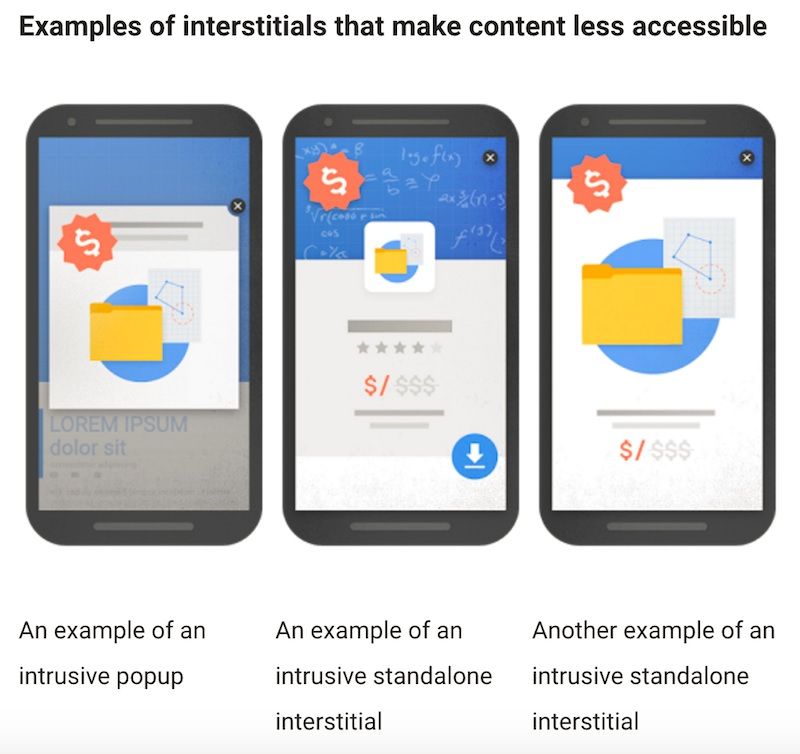
In the same blog post in which Google laid out its plans to penalise unfriendly interstitials, Google announced that it would be getting rid of the 'mobile-friendly' label which has been a mainstay of the mobile search page for the past two years.
Designed to help users find content "where the text and content was readable without zooming and the tap targets were appropriately spaced", Google has decided that the 'mobile-friendly' label has outlived its purpose now that 85% of pages in the mobile search results now meet this criteria.
Score one for the mobile web!
Google removes its AdSense ad limit policyGoogle was recently spotted changing its ad placement policies for AdSense to remove the 'ad limit per page' section. Search Engine Journal reported on the change this week, and contacted Google to confirm that it had indeed removed the limit on advertising.
From Search Engine Journal:
Using the WayBack Machine, you can see that the policy once read as follows:
"Currently, on each page AdSense publishers may place:– Up to three AdSense for content units– Up to three link units– Up to two search boxes
Publishers may not place more than one "large" ad unit per page. We define a "large" ad unit as any unit similar in size to our 300×600 format. For example, this would include our 300×1050 and 970×250 formats, our 750×200 and 580×400 regional formats, and any other custom sized ad with comparable dimensions."
Now, you can see in Google's current ad placement policies that the 'ad limit per page' section has been removed. It has been replaced with a section titled 'valuable inventory', which cautions site owners not to let the amount of ads on a page exceed the amount of actual content. Doing so may result in Google limiting or disabling ads served on the page until appropriate changes are made.
Search Engine Journal's article delves into Google's reasons for the change, which includes reducing the amount of slideshow-based content designed to get around the ad limit, and encouraging advertisers to use new mobile-friendly ad units.
SEJ writer Matt Southern considers whether publishers might begin to abuse their advertising privileges now that the limit has been lifted. But I can't help noticing that the new guidelines also make the terms under which Google can penalise content a lot more subjective.
Will this cause problems for publishers when they run afoul of rules they didn't even realise have changed?
AMP now supports A/B testingGoogle's Accelerated Mobile Pages (AMP) initiative continues to evolve. At the beginning of this month, Google announced that AMP support is being rolled out across the entire organic search results page on mobile. Kenny Chung has taken a detailed look at who benefits from implementing AMP in the wake of the update.
Now, The SEM Post's Jennifer Slegg has reported on a change that might make implementing AMP more appealing to businesses and marketers: AMP now supports A/B testing.
"If you have been wanting to do some A/B testing on your AMPlified page performances, AMP is now supporting a new <amp-experiment> which gives publishers flexibility to test variations of pages. This is especially good news for those publishers wanting to monetize better as well as for advertisers that are currently testing out using AMP for landing pages."
You can read the full announcement on AMP's blog here.
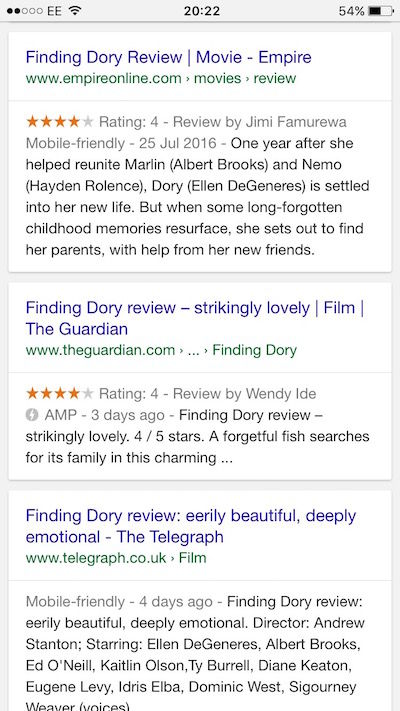 AMP results featured in organic mobile search
AMP results featured in organic mobile search
Finally, we have some interesting revelations from Ofcom's 2016 Communications Market Report about the popularity of 'digital detoxing' in the UK. According to the report, 15 million UK internet users, or 34%, have spent a period of time offline in order to strike a healthier balance between technology and offline life.
The report also found that digital detoxes were most popular with the most wired-in age group: 16-24-year olds, 52% of whom have taken a digital detox in the past year. On the flip side, 34% of internet users say they "would definitely not like to do a digital detox".
Luke Richards gives more details about the report's findings on digital detoxing and what they mean in his article for Search Engine Watch.
Want to stay on top of the latest search trends? Get top insights and news from our search experts.
Related readingWelcome to our weekly round-up of all the latest news and research from around the world of search marketing and beyond.
In a poll conducted to accompany the ClickZ Intelligence Digital Trends 2016 report, nearly a quarter of respondents identified content marketing as the key trend for their company this year.
What do you imagine is the future of search?
New research show a disparity in sales growth between pure-play online retailers and their multichannel counterparts.
Buy AutoTrafficRSS script now for $27 only!
We will send the script to your PayPal email within few hours,Please add FullContentRSS@gmail.com to your email contact.
In my blog titled "Keywords: What you should and shouldn't do," I got so excited about sharing my SEO knowledge that I forgot a crucial point: Start at the beginning!
Let's say hypothetically that your brand has just created a website. It has awesome images, lots of good information and maybe even an e-commerce component. You're super-proud of it and all the hard work—time and expense—you've put in it. Unfortunately, none of this will matter if your website isn't indexed.
What does indexing mean?As of August 24 2016, the World Wide Web contains approximately 4.73 billion indexed pages. This is just the number of pages that search engines such as Google, Bing and Yahoo know about—there are many more.
When a web page is "indexed," that page is on a search engine's radar. The engines know that the page exists, and it can be found as a result of a search. This is a priority for your website. Indexing your site allows more people to reach you.
If a search engine doesn't know your page exists, then it won't list your site in the search results, which means people won't find you.
Crawling and IndexingGoogle and other search engines use software referred to as "web crawlers" to discover new and updated web pages. Once they have found the website, they move around on the page collecting data and following links, much like consumers would. This information is then brought back to the search engine's servers.
This is how search engines find out about pages that aren't loading, no longer exist or have been recently updated. More often than not, there aren't any extra steps involved in getting your website crawled. However, if pages aren't linked to each other and aren't functioning correctly, they can easily be missed by crawlers.
Once the search engines' servers have that data, they have to organize it so they know how to look up pages. To put it simply: Search engines follow algorithms to create a huge index. They pair the information they've gathered with the searches that come in on a regular basis.
Unfortunately there will always be pages that fall through the cracks or take a long time to get indexed. Thankfully, there's something you can do about it.
Aiding in the indexing processHere are some easy steps to make sure the crawling/indexing process is going smoothly—and accurately—for your website.
• Domain Name: As I have mentioned in previous posts, your URL has a huge impact. It's a great place to use your keyword and gets the attention of search engines. You will want to have the names of your URL's decided before sending in your sitemap.• Create and submit an XML sitemap: Your sitemap is just that—a map of the URLs within your website. You can submit your sitemap to Google through Google Search Console. Speaking of which …• Start using Google Search Console: This tool will allow you to see your website as the search engines see it—this will be great for identifying problem pages and making updates.• Clean up any "dead" pages: If a link goes to a page that is no longer published, it will result in an error message. When a crawler finds these, they assume there is nothing left to crawl, or at the very least, slows down the process.
In good news, social media pages—which are huge for a company's brand--don't require indexing. Sites like Facebook and Twitter act as their own search engines with their own algorithms.
Also keep in mind that there are a large number of pages getting crawled and indexed every day- sometimes it just takes time. By getting your website indexed and regularly crawled, your website's traffic will increase, therefore, so will your sales.
Buy AutoTrafficRSS script now for $27 only!
We will send the script to your PayPal email within few hours,Please add FullContentRSS@gmail.com to your email contact.
Content Marketing is an increasingly popular strategy for online user engagement and a successful brand identity. The budget for a quality content keeps growing and the momentum does not seem to lose. The reason is quite simple. Content marketing provides various benefits to a brand and its marketing strategies:
10 of the most common reasons for a failed content marketing strategy are:
1. Lack of a clear and composed plan.2. Incorporation of old and irrelevant data for building strategies.3. Inconsistent, useless and low quality content.4. An approach to preach rather than teach.5. Showing yourself as an amateur.6. Lack of a clearly defined goal and a Call to Action.7. Evanescent content.8. Poor targeting.9. Absence of SEO to reach target audience.10. No review of performance.
Make An Effective Content Marketing CampaignLet me give you a step by step approach to build an effective content marketing campaign:
Step 1: PlanCareful planning is a key to success in any kind of domain, especially in the digital sphere where trends emerge and fade on a daily basis.
There are many factors which go into making a successful and productive content marketing plan:
1. Set Goal- Ask yourself, what do you want out of this?
Don't just answer more business. Be specific and more comprehensible like the below chart.
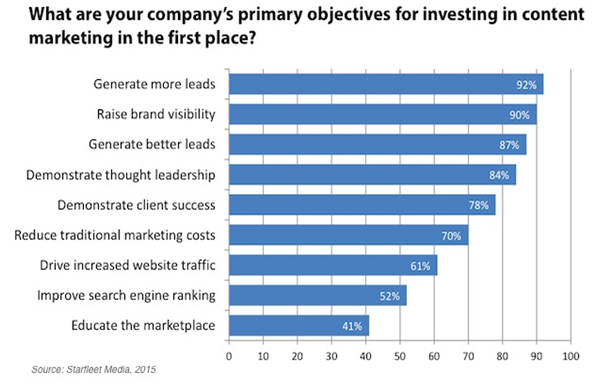
2. Set a budget- Set a budget and more importantly stick to it. With time the budget for marketing the content is increasing. Short sightedness in this step can make your finances go haywire.
After the overall budget, you need to allocate it for different tasks. Arrange the operations in order of importance and fix funds for each item.
3. Assess the trend- Decide the type of content based on the market trend. For instance this post came up with an interesting concept by fusing two very hot topics like branding and Game of Thrones. Be creative and come up with similar topics. It is no use to invest your time on a stale and dead trend. Use the below tools to find the in thing.
a.Google Trends- It is one of the most widely used free tools which shows exhaustive data about the latest trends according to interests and also for a particular keyword.
Check real time data: change the timeline to past day or past hour and gauge at real time data about a specific keyword like in the image below.
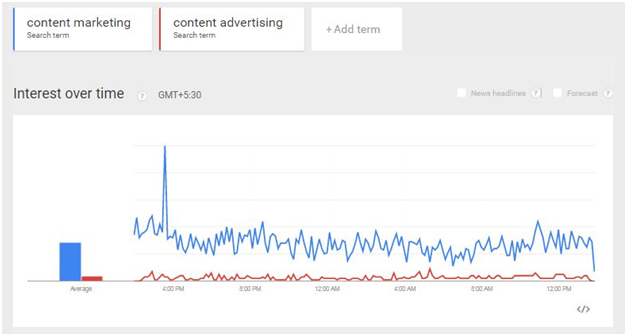
Compare the performance of keywords.
Check data for smaller demographics and more specific data.
b.Buzzsumo- It is an amazing tool which tells you about the performance of a content and breaks it down by multiple metrics across domains, keywords or topics.
Exhaustive filters enables you to see more specific results.
Get alerts for specific keywords and links.
c.EpicBeat Epictions- One of the best platform to find latest trends contents and influencers in your niche. Just search for the keyword and check the extremely detailed analysis by content. The representation of data is pretty smooth.
Find popular days to publish the content.
Extremely detailed analysis of user behavior according to the choice of platform. Here it shows data for twitter.
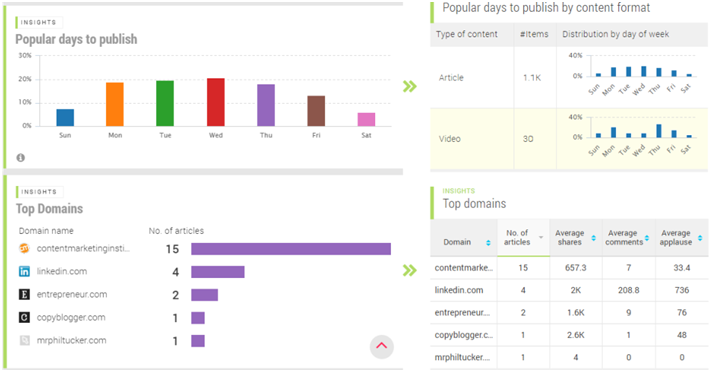
4. Use additional sources to gauge market trends. Each platform has its unique way to filter rising topics.
Find custom topics in the search bar. Results can be sorted according to the type of content.
Research your market by medium of surveys and questionnaires to gather more specific information about a brand and consumer needs. The popular beer brand Heineken conducted a researchat their annual conference and collected more than 5800 responses to get valuable insights into their customers satisfaction levels.
Use tools to conduct similar surveys and research:
5. Direct your campaign- After checking the latest trends and gathering data, analyze the pro-cons of different topics. Decide a target audience and start to think about the direction in which you want to drive your campaign.
Step 2: DecideAfter gauging data of several ideas choose the one which shows the potential of maximum ROI. Easy isn't it?
But it is not, you need to pay attention to various aspects before coming to a decision.
Remember to:
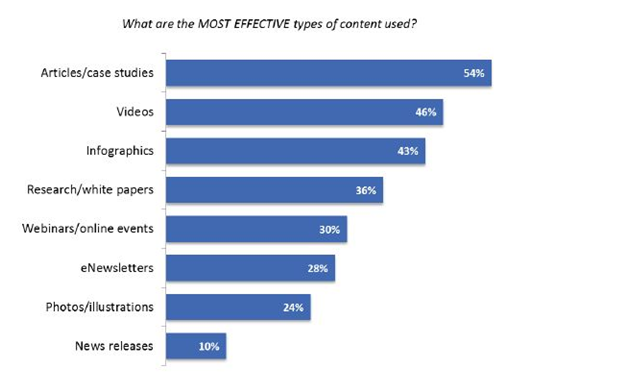
Now you have an exhaustive plan at your disposal and should start creating content. Pay attention to the following methodology to make your content more interesting and relevant for your users:
1. Have ample resources. It includes having capable writers, an article bank, an SEO strategy, good quality images, infographics and videos.
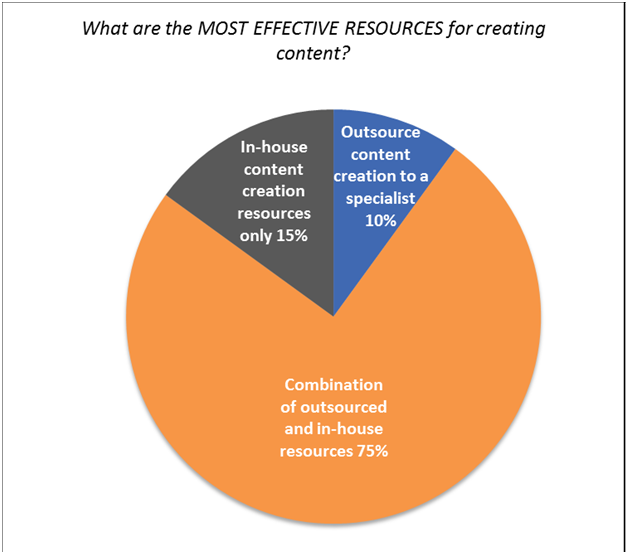
2. Keep the text interesting- Text tends to go boring and redundant after a while. Keep it short and to the point without straying away from that UNIQUE PURPOSE.
Write in form of points instead of long paragraphs.
DO NOT indulge in singing praises and legacy of your brand. Just get to the point quickly.
Catchy subheadings- They complement your content and make it more readable. Keep your subheadings and title attractive by:
Be creative and come up with innovative ideas like this old spice commercial that was able to drive engagement due to it's unique approach to branding.

3. Use proper typeface and colors- The color and font of your website must go along with your brand Identity. Along with the relevancy it must be pleasant and soothing. Use webfonts to come up with interesting fonts like below.
4. Add graphics- One of the most engageable form of displaying content is the use of visual imagery. A visually pleasing web page can enhance the user experience (UX) exceptionally:
5. Give a simple and straightforward Call to Action (CTA). ALWAYS tell your audience what to do next after reading your content. Some tips to create an attractive call to action:
Give your audience only the CTA to look at and nothing else. Make it stand out from the rest of the content.
Tell your readers why they should undertake an action. Tell them why its good.

Munchery makes effective usage of Facebook for marketing their content, they often start off with a question and give a CTA at the end to answer that question.

6. Optimize your web page- Your platform needs to be optimized for best UX:
Use images in the proper format (vector or raster) for smoother loading.

Reducing size of your image can significantly boost your loading time. Amazon found out that a mere 1 second delay costs them $1.6 billion a year. Check out the page abandonment rate with respect to the page load time below
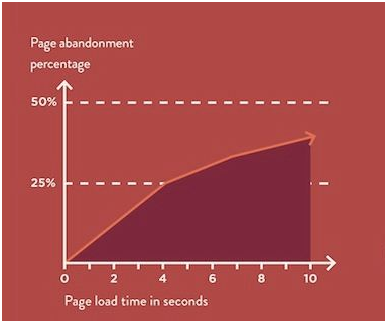
After you have successfully created content, the next and a major step is to make it more discoverable for your audience:
1. Create a sitemap and submit it to Google search console (previously webmasters tool). A sitemap helps the search engine to read your content and display in the search results. Without using it, your website will not even appear in the organic results!
2. After submitting the site map, SEO your page to rank higher in the natural search results. Use these tips:
Use tools to find influencer and business leads to automate your outreach. Influencers are the contributors in a specific field who already have a strong following:
Ninja outreach- It is a highly recommended tool to find influencers related to a specific keyword. You can even find social media influencer in specific niche.
Klout- One of the most well known influencer discovery and engagement platforms. It is a paid service that analyzes individual social network content to curate a klout score.Post content regularly. A blog or a website which does not post weekly falls down disastrously in the Google ranks.
Link your content to and from various relevant pages over the internet. Check in the graph below how important links are. Top two Google ranking factors are links!
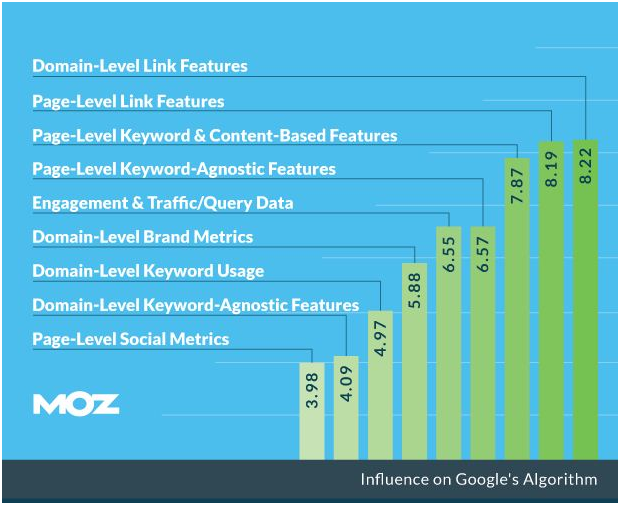
Create videos for boosting your marketing strategy. It works wonders for SEO.79% of content by 2018 will be video.Videos garner 4 time more CTR.Video shows 65% more retention rate.Having a video in your content increases your chances to be in the first page of Google ranks by 53 times!
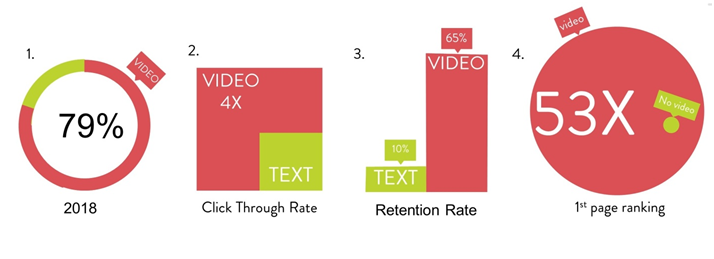
3. Use PPC if your budget allows. Undertake PPC on different search engine platforms like Bing, AOL etc.
4. Use Social Media extensively. It is cost effective and caters to a VERY large organic audience.
You have successfully created and implemented a marketing strategy. But no, its not time to rejoice, not just yet.
You need to evaluate and measure the success of your content. What you measure is more important than how you measure it:
1. Use dedicated behavior analytics software. Google Analytics serves the purpose well.
Review your user base. Their age, demographics, gender etc.
Analyze the basic user behavior like which page they stay on, how long they stay, which page makes them disengage.
Gauge the performance of your keywords and evaluate which keywords are performing well and which are not generating any tangible audience.
Check if the users are actually finding your content to be useful.
Do a cohort analysis to review users re-engagement.
Sign in to google analytics-> navigate to your view-> select reporting tab-> audience-> cohort analysis
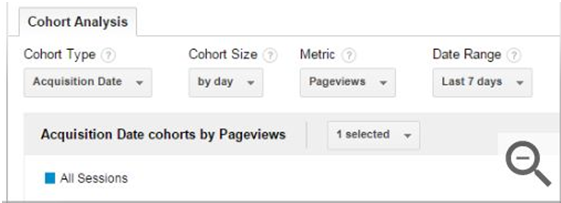
Other tools for analysis of the user behavior on your website:
Features:
SPSS Modeler- predictive intelligence to decisions made by individuals, groups, system and enterprises.SPSS statistics- Ranges from planning to data collection to analysis, reporting and deployment.
Features:
Easy and intuitive to use- Includes process zoom, simple connection deletions and progress display.Data visualization- support for OData web services, flexible analysis through visual tools
Features:
Data transformation, model analysis, data sampling, binning, discretization etc.Regression, clustering (O-cluster), support vector machine.
The key signs of success of content is realized when we examine the change in user behavior as a result of the content.
After evaluating the audiences response on your content make use of the gathered data to drive your next marketing campaign.
Start over with the above procedure to go about for the next cycle.
Hand-Picked Related Articles:* Adapted lead image: ![]() Public Domain, pixabay.com via getstencil.com
Public Domain, pixabay.com via getstencil.com